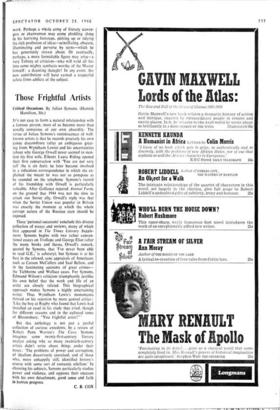Those Frightful Artists
IT'S not easy to form a natural relationship with a famous person; most of us become more than usually conscious of our own absurdity. The virtue of Julian Symons's reminiscences of well- known artists is that he records precisely his own comic discomfiture (after an ambiguous greet- ing from Wyndham Lewis) and his uncertainties (about why George Orwell never seemed to men- tion his first wife, Eileen). Laura Riding opened their first conversation with 'You are not very tall' (he is six feet); he later became involved in a ridiculous correspondence in which she ex- plained she meant he was not so pompous as he sounded on the telephone. Symons's record of his friendship with Orwell is particularly valuable. After Gollancz rejected Animal Farm, on the ground that 1944 was not the time to attack our Soviet ally, Orwell's reply was that when the Soviet Union was popular in Britain was exactly the moment at which the whole corrupt nature of the Russian state should be exposed.
These 'personal occasions' conclude this diverse collection of essays and reviews, many of which first appeared in The Times Literary Supple- ment. Symons begins with two rather conven- tional essays on• Trollope and George Eliot (after the many books and theses, Orwell's remark, quoted by Symons, that 'I've never been able to read G.E.,' is salutary); but Symons is at his best in the relaxed, sane appraisals of Americans such as Carson McCullers and Saul Bellow, and in the fascinating accounts of great crimes— the Tichborne and Wallace cases. For Symons, Edmund Wilson's criticism triumphantly justifies his own belief that the work and life of an artist are closely related. This biographical approach makes Symons a highly entertaining writer. Thus Wyndham Lewis's monomania thrived on his rejection by more genteel critics : 'Like the boy at Rugby who found that Lewis had installed an easel in his study they cried, though for different reasons and in the cultured tones of Bloomsbury, "You frightful artist!"' But this anthology is not just a zestful collection of curious anecdotes. In a review of Robert Penn Warren's The Cave. Symons imagines some twenty-first-century literary analyst asking why so many twentieth-century artists didn't write about things under their noses : 'The problems of power and corruption, of idealism disastrously exercised, and of those who, more unhappily still, identified history's course with some sort of romantic nihilism.' In choosing his subjects, Symons particularly studies power and violence, and opposes their excesses with his own detachment, good sense and faith in human progress.
C. B. COX






































 Previous page
Previous page